VIRTUAL ITALIAN ORGANS
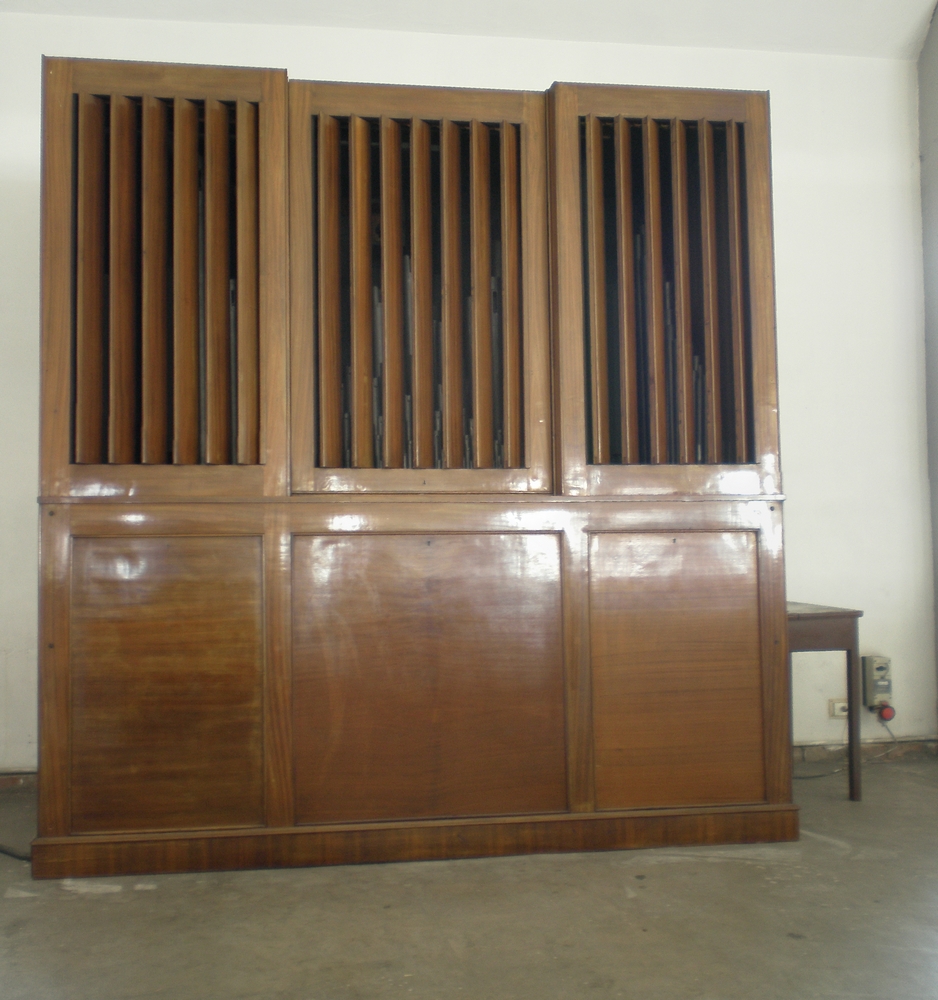
Located in the north-western outskirts of the city of Milan, the district takes its name from the Eighth Triennale d'Arte ("QT8", Quartiere Triennale 8) of 1947, in the context of which its particular urban layout was conceived which also involves the parish church of Santa Maria Nascente. Today the district is a residential area with large green spaces: behind the church is the "Monte Stella", a large city park whose centerpiece is a hill obtained by burying the rubble of the Anglo-American bombings of 1943-44 and from which summit you can enjoy a vast panorama that embraces the entire city of Milan allowing the gaze to sweep, on clear days, from the Alps to the Apennines.
Here more information on "Quartiere T8".
The church of Santa Maria Nascente was opened for worship in 1955: not large in size, it has a composite plan, formed by a cylindrical body enclosed by a volume with a sixteen-sided plant off-centered in the direction of the entrance, which defines inside the half-height gallery in which the choir with the organ is located.
The seventeenth-century sanctuary of the village of Lampugnano is also part of the parish: the dedication to Santa Maria Nascente, then maintained for the more recent parish church, is due to the fact that in the sixteenth-seventeenth centuries the canons of the Milan Cathedral went on holiday to that place, then open countryside, where they wanted to build a small church in which to celebrate Mass - a church to which they gave the same title as the Metropolitan Cathedral.
Here more information on the church and parish of Santa Maria Nascente.
Built by the Giovanni Tamburini company of Crema in 1959 according to their standard "E2" model, the small organ of S. Maria Nascente makes use of the so-called "multiplex system", in which a limited number of real ranks are used to obtain homologous stops of different tonal height.
Movable console with two 61-note keyboards and 32-note pedalboard.
Stops with pivot plate on the front above the manuals.
| Manual I | Couplers | Manual II | Pedal |
| PRINCIPALE 8' | UNIONE I/P | BORDONE 8' | SUBBASSO 16' |
| BORDONE 8' | UNIONE II/P | SALICIONALE 8' | QUINTA 10'2/3 |
| SALICIONALE 8' | UNIONE II/I | FLAUTO 4' | PRINCIPALE 8' |
| OTTAVA 4' | ACUTA I | SALICET 4' | BORDONE 8' |
| FLAUTO 4' | ACUTA II/I | NAZARDO 2'2/3 | DOLCE 8' |
| DECIMAQUINTA 2' | GRAVE II/I | OTTAVINO 2' | |
| RIPIENO 5 FILE 2' | ACUTA II | DECIMA IX 1'1/3 | |
| ACUTA II/I | VOCE CELESTE 8' (also inserts the Salicionale 8') | ||
| TREMOLO |
Borrowing scheme:
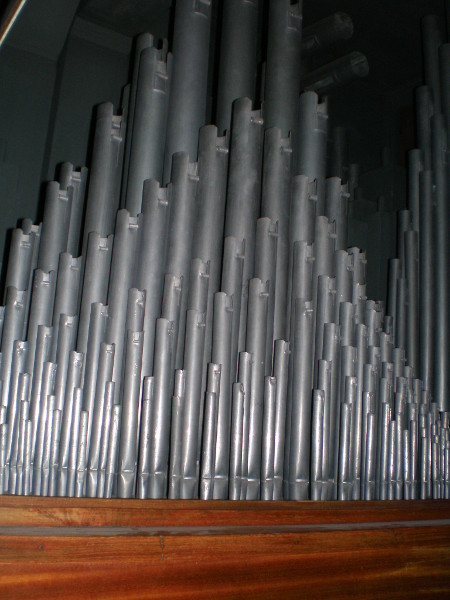 PRINCIPALE 8', 85 pipes:
PRINCIPALE 8', 85 pipes:
Manual I: Principale 8', Ottava 4', Decimaquinta 2'
Pedal: Principale 8'
BORDONE 8', 85 pipes:
Manual I: Bordone 8', Flauto 4'
Manual II: Bordone 8', Flauto 4', Flauto in XII 2'2/3, Ottavino 2'
Pedal: Subbasso 16' (from C 25 to G 32), Quinta 10'2/3 (from F 18 to G 32), Bordone 8'
SALICIONALE 8', 73 pipes:
Manual I: Salicionale 8'
Manual II: Salicionale 8', Salicet 4', Decima IX 1'1/3
Pedal: Dolce 8'
RIPIENO 5 FILE 2', 240 pipes:
Manual I: Ripieno 5 file (from C 1 to H 60, C 61 borrowed from 49)
VOCE CELESTE 8, 49 pipes:
Manual II: Voce Celeste 8' (also inserts the Salicionale 8')
SUBBASSO 16, 24 pipes:
Pedal: Subbasso 16' (from C 1 to H 24), Quinta 10'2/3 (from C 1 to E 17)
The organ is entirely expressive; the system consists of a windchest for the bass pipes (Subbasso 16', Principale 8' from C 1 to D 15, Bordone 8' from C 1 to G 8, Salicionale 8' from C 1 to G 8), a major windchest on which contains the rest of the pipes and a small wind chest dedicated to the Voce Celeste pipes. The Tremolo does not involve the bass windchest, whose pipes are unaffected - including those that also play the manuals.
In spite of the extremely modest dimensions and a stops list obtained by making extensive use of borrowing, the very lively and full of personality character of the six ranks allows sound combinations of a variety which at first sight is unsuspected.
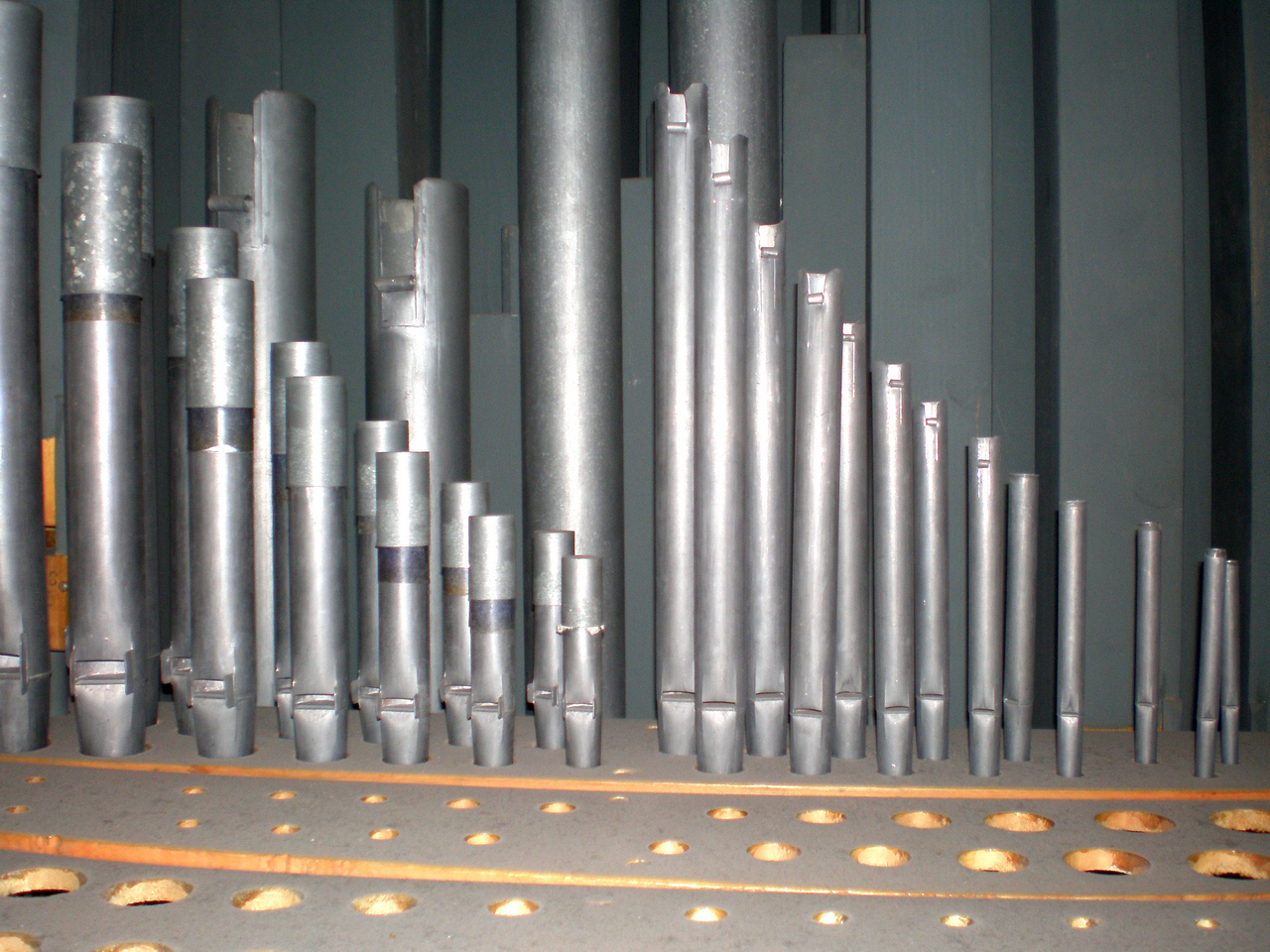
This result is possible not only thanks to the stability of the intonation (the merit of which goes in large part to a rather high air pressure by Italian standards: about 90 mm for the major wind chest and 80 for the bass pipes one) but also to a meticulous sound design.
Let's take as an example the Bordone 8', which more than any other register takes care of derivations and extensions both to the manuals and to the pedal (including the entire pyramid of 8, 4, 2 2/3 and 2 at II). The register is made up of corked wooden pipes from C 1 to F 18, with a narrow size and high mouths; from F# 19 to G 44 the pipes are in metal, capped, of narrow size and with wide and high mouths; from G# 45 up to C 85 the pipes are open and harmonic, with diameters corresponding to those of the homologous pipes of the previous octave but with significantly narrower and lower mouths.
In this way the balance in the sound intensity is maintained, but the gradual tonal variation along the extension allows a convincing differentiation in the borrowed registers of Flauto 4', Flauto in XII 2' 2/3 and Ottavino 2'.
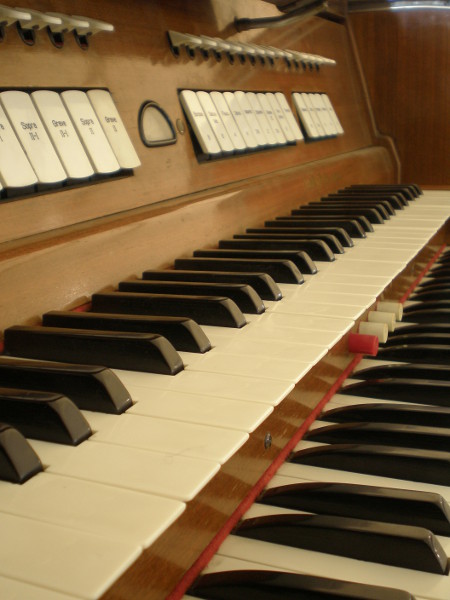 As mentioned in the information page, the Tamburini organ of S. Maria Nascente currently no longer plays: in 2020 it was dismantled following a radical internal restructuring work that forced it to close for over a year. But when it reopened on 8 December 2021, the instrument was no longer reassembled following a unilateral decision by the pro tempore parish priest and has since been replaced by a modest Trühenorgel.
As mentioned in the information page, the Tamburini organ of S. Maria Nascente currently no longer plays: in 2020 it was dismantled following a radical internal restructuring work that forced it to close for over a year. But when it reopened on 8 December 2021, the instrument was no longer reassembled following a unilateral decision by the pro tempore parish priest and has since been replaced by a modest Trühenorgel.
A Trühenorgel, even if of discreet workmanship, is obviously absolutely insufficient to replace the Tamburini which, despite its extreme modesty, boasted at least a complete technical-phonic equipment and perfectly suitable both for use in liturgy and for the performance of a very large repertoire: in addition, the choice aroused great bewilderment among the parishioners who remembered the Tamburini in perfect working order - moreover, it was subject to a substantial maintenance in 2015, which makes its replacement with an organ with far less musical possibilities even less understandable.
We do not know the reasons that led the current parish priest of S. Maria Nascente to put aside the Tamburini organ: in trying to reconstruct the story, which presents numerous unclear points, we have collected the testimonies of passing organists in the parish, some parishioners and the organ builder Ilic Colzani (author of the dismantling and supplier of the current Trühenorgel) who have provided us with different and sometimes conflicting versions.
From what we have been able to understand, it seems that the initial project was to replace the Tamburini with a "German organ" to be purchased in second-hand (with all the uncertainties and burdens of the case); the deal would however have vanished, but instead of the most logical solution - the reassembly of the Tamburini, perhaps expanding it and updating it if it was found so inadequate - the parish priest refused the old instrument, preferring to continue the rental of the Trühenorgel already in use during the renovation works. At this stage, we were witnessed at least of the intention to put the dismantled materials of the Tamburini on sale.
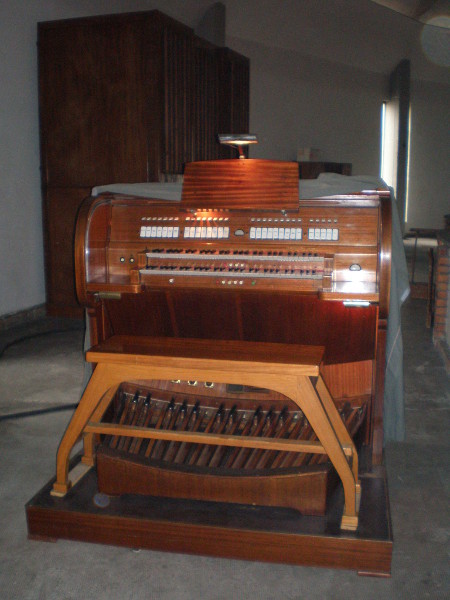
In the end, to our request for clarification which also involved the competent offices of the Milanese diocesan Curia since it was a question of the possible alienation of a significant asset owned by the parish, the parish priest answered us in a dry and unfriendly way, pointing out that the parish is not obliged to give reasons to strangers for choices concerning assets pertaining to him. However, he went on to say that "The Tamburini organ necessarily had to be dismantled due to the reclamation and restoration work to which the Church was subjected. It has not been alienated nor is it currently on sale. To date it is deposited in the premises of the parish itself. The future of the instrument will be taken into consideration at the conclusion of the work still being completed."
But the church was solemnly inaugurated on December 8, 2021: and as we write, at the beginning of March 2022, the organ is still disassembled and - at least as far as we know - there is no intention of reassembling it, and perhaps not even to keep it...
For the sampling of the little Tamburini - which at this point we believe to be the only remaining testimony of the instrument - we made use of sound taps carried out in 2015, the day after the extraordinary maintenance performed by the organ builder Pietro Corna. The original purpose of the recordings was to have a precise phonic relief of the instrument, but the good length of the samples and the reduced distance of the microphone from the organ made the material perfectly suitable for obtaining a good dry channel.
The acquisition was performed as usual at 96 kHz and 24 bit, reduced to 48 kHz after processing.
From the dry channel, with the same method applied in the case of Malpaga, a convincing wet channel - with five levels of multiple releases - was obtained by means of a IR which reproduces the acoustics of the church of S. Maria Nascente in a very credible way.
Memory requirements:
16 bit, only dry: 401.65 MB
24 bit, only dry: 708.48 MB
16 bit, complete: 2885.11 MB
24 bit, complete: 5565.92 MB
The graphic interface consists of six tabs.

The façade of the Tamburini organ is reproduced, consisting of the expressive shutter that closes the small instrument.

The "Original" panel is dedicated to reproducing the Tamburini organ as faithfully as possible, both in the stop's list and in the accessories: the version of the sample set for Hauptwerk 4.21 and above reproduces the Tamburini console as faithfully as possible in all its functions.
Next to the photographic reproduction, as is now customary in our sample sets, there is a panel in which each command is reproduced in a more readable and above all more accessible way to users with touch screens: each panel command activates its counterpart in photographic reproduction, which allows a very realistic view of the operation of the original console.
The only exceptions are keyboards, pedalboards and pedals for Crescendo and Swell, whose MIDI assignment is possible directly from the photographic reproduction - or, in the case of the two pedals, from the "PEDAL MATRIX" panel.

Two panels are dedicated to the extended version of the sample set which are identical in the 16: 9 format but which, in the vertical format, respectively show the left half (I manual and Pedal) and the right half (II manual and part of the Pedal), for the benefit of dual monitor users.
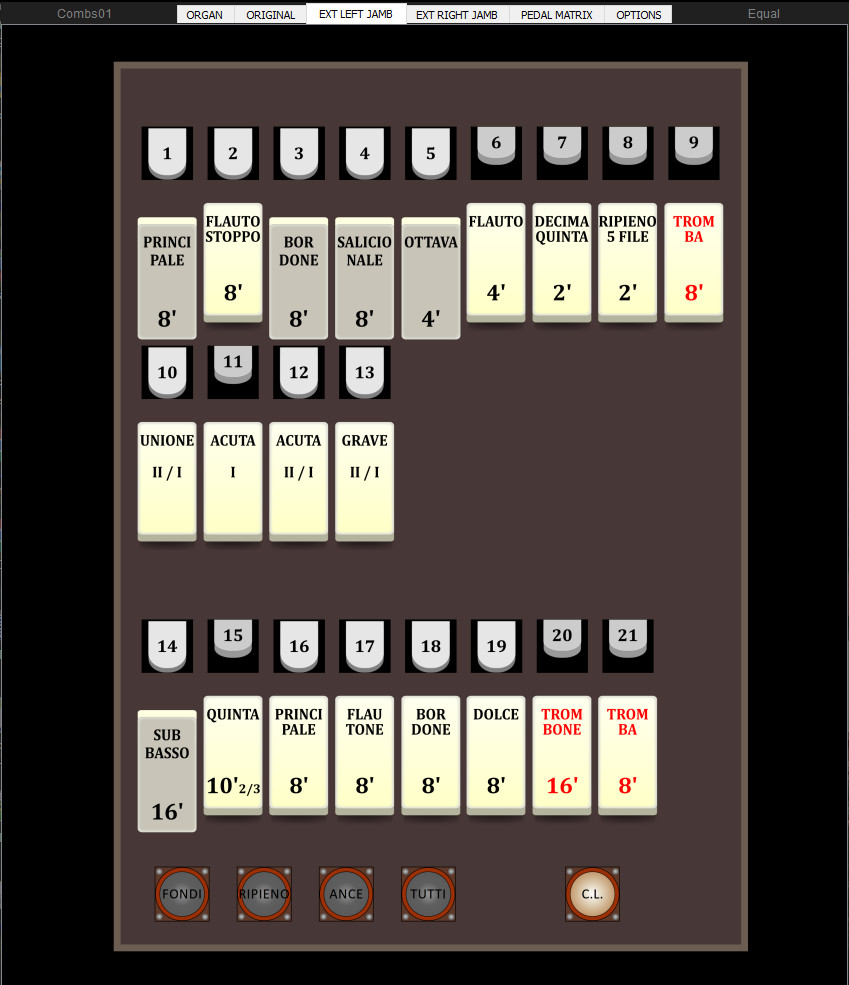
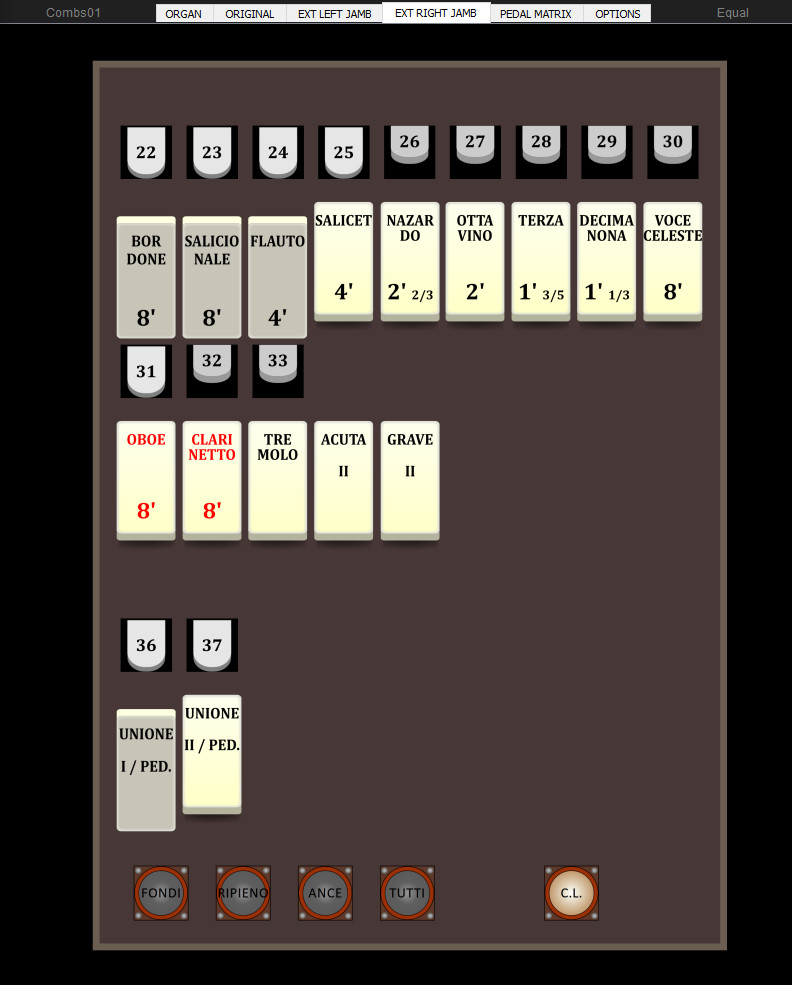 In the extensions there are four reed stops, the absence of which is one of the greatest limits of the original Tamburini organ: in addition to the 8-foot Trumpet at the I manual, two detail registers at the II, Oboe 8 and Clarinet 8 and a powerful 16-foot Trombone on pedal. The 8-foot Flauto Stoppo installed in the Tamburini organ with the 2015 revision has also been added to both the manual and the pedal - which, as in the original instrument, is not subject to the action of the Tremolo. The 8-foot Trumpet has also been excluded, since it is a register with a strong sonority. Finally, the pyramid of the flutes in the second manual was completed with a Terza 1'3/5 obtained from the samples of Bordone 8'.
In the extensions there are four reed stops, the absence of which is one of the greatest limits of the original Tamburini organ: in addition to the 8-foot Trumpet at the I manual, two detail registers at the II, Oboe 8 and Clarinet 8 and a powerful 16-foot Trombone on pedal. The 8-foot Flauto Stoppo installed in the Tamburini organ with the 2015 revision has also been added to both the manual and the pedal - which, as in the original instrument, is not subject to the action of the Tremolo. The 8-foot Trumpet has also been excluded, since it is a register with a strong sonority. Finally, the pyramid of the flutes in the second manual was completed with a Terza 1'3/5 obtained from the samples of Bordone 8'.
In the extended version, another modification made in 2015 has also been reproduced, which consists in having released the Voce Celeste from the Salicionale (in the "Original" screen, which rigorously reproduces the original Tamburini, the two registers are instead bound and the Voce Celeste also inserts the Salicionale).

The reproduction of an organ equipped with the typical devices of electric transmission consoles has given us the possibility, for the first time in our sample sets, to prepare a panel for programming the Crescendo: given the smallness of the images in the photographic reproduction, we have took the opportunity to implement a more comfortable display of the two pedals in the console.
The Crescendo has 21 shots that can be programmed using the appropriate table: the memories in the top right panel allow you to set and subsequently recall four sequences of your choice.
The "ORIGINAL TAMBURINI" button returns the programming to the specifications corresponding to the original Tamburini organ.

The Options page is divided into four sections.
The upper left panel allows you to adjust the listening position, highlighted by the movement of the pair of microphones on the stylized plan of the church. The two buttons "Only wet" and "Only dry" allow you to isolate the two respective channels: when they are deactivated, you automatically return to the balance established by the "Change listening position" knob.
At the center are the Tremolo adjustments: as in the Positive OTT, the two sliders regulate the inlet and outlet of the air. There are four programmable memories: in the lower part of the panel three buttons are used to restore the default values (with an effect similar to the original Tamburini) and to choose between Tremolo using the wind model and standard Hauptwerk Tremolo.
The panel for adjusting the random detuning is equipped with two independent sliders for the flue stops and for the reeds stops.
The lower part of the screen schematically shows the bellows of the Tamburini organ, which can be "turned off" by clicking on the motor symbol on the left (or on the motor button in the photographic reproduction).
R. Lomurno, "Impro 1812" (improvisation performed while testing the sample set)
Thanks to M° Roberto Lomurno for having granted the publication of the audio
Charles Renaud de Vilbac (1829-1884) - "Communio sur Bellini" (performance of Alfred Piseki)
Thanks to Alfred Piseki from Wien for having granted the publication of the audio
Paul Page - "Cantabile Sacra One Hundred Seven" (performed by Alberto Guerzoni)
Thanks to M° Alberto Guerzoni for having granted the publication of the audio
The demo version of the sample set for Hauptwerk 4.21 and all later versions is fully functional, but the sound is disabled periodically; to download it, send a request by email via the button below.
Warning: do not change the subject of the message! The correct sending of the response containing the link to the sample-set depends on it.
If the sample set is considered satisfactory, the full version may be requested after the trial period (see the instructions in the email containing the link to the demo).
The version for GrandOrgue is based on a sampling performed in 2011 and has only the dry channel and a simplified graphic interface: to request it click below
Request the GrandOrgue version
Can't request the sample set or haven't received a response? Contact us by writing to:
